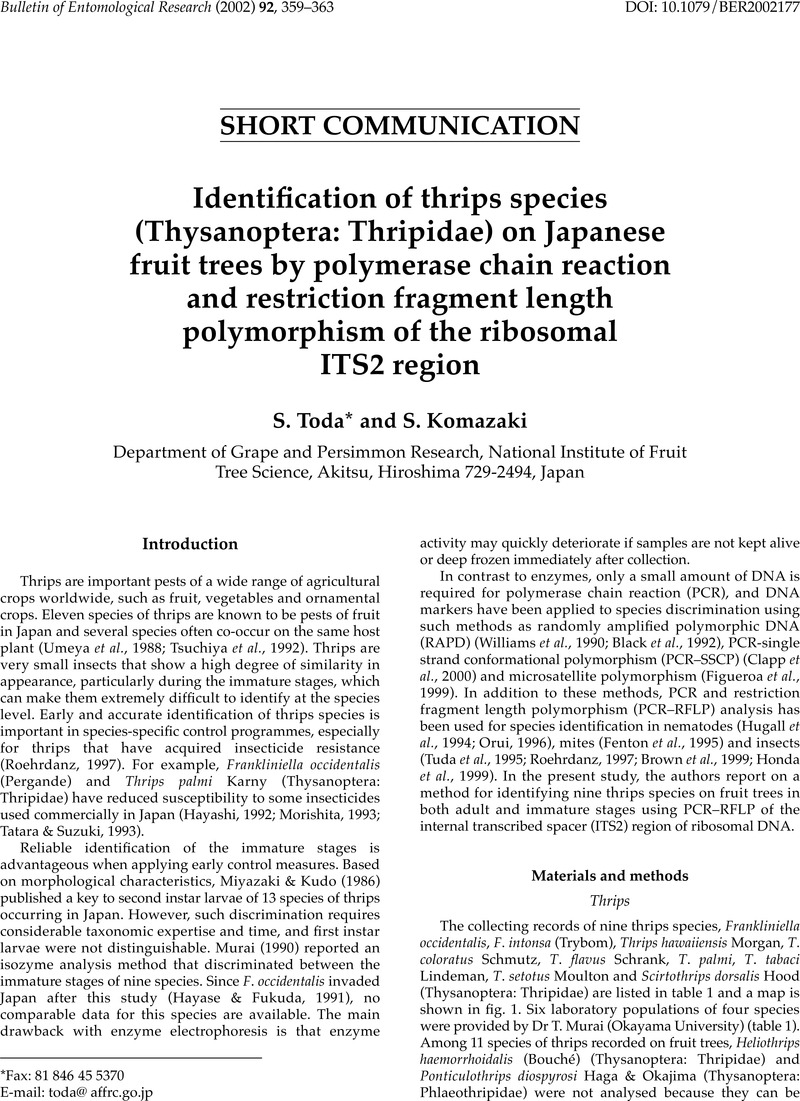Crossref Citations
This article has been cited by the following publications. This list is generated based on data provided by Crossref.
Wagener, B.
Reineke, A.
Löhr, B.
and
Zebitz, C.P.W.
2004.
A PCR-based approach to distinguish important Diadegma species (Hymenoptera: Ichneumonidae) associated with diamondback moth, Plutella xylostella (Lepidoptera: Plutellidae).
Bulletin of Entomological Research,
Vol. 94,
Issue. 5,
p.
465.
Morris, David C
and
Mound, Laurence A
2004.
Molecular relationships between populations of South African citrus thrips (Scirtothrips aurantii Faure) in South Africa and Queensland, Australia.
Australian Journal of Entomology,
Vol. 43,
Issue. 4,
p.
353.
Kox, L. F. F.
Van Den Beld, H. E.
Zijlstra, C.
and
Vierbergen, G.
2005.
Real‐time PCR assay for the identification of Thrips palmi*.
EPPO Bulletin,
Vol. 35,
Issue. 1,
p.
141.
Armstrong, K.F
and
Ball, S.L
2005.
DNA barcodes for biosecurity: invasive species identification.
Philosophical Transactions of the Royal Society B: Biological Sciences,
Vol. 360,
Issue. 1462,
p.
1813.
Walsh, K.
Boonham, N.
Barker, I.
and
Collins, D. W.
2005.
Development of a sequence‐specific real‐time PCR to the melon thrips Thrips palmi (Thysan., Thripidae).
Journal of Applied Entomology,
Vol. 129,
Issue. 5,
p.
272.
Morse, Joseph G.
and
Hoddle, Mark S.
2006.
INVASION BIOLOGY OF THRIPS.
Annual Review of Entomology,
Vol. 51,
Issue. 1,
p.
67.
Chu, Chang-Chi
Ciomperlik, Matthew A.
Chang, Niann-Tai
Richards, Marcus
and
Henneberry, Thomas J.
2006.
DEVELOPING AND EVALUATING TRAPS FOR MONITORING SCIRTOTHRIPS DORSALIS (THYSANOPTERA: THRIPIDAE).
Florida Entomologist,
Vol. 89,
Issue. 1,
p.
47.
2006.
THIS ARTICLE HAS BEEN WITHDRAWN: Thrips palmi.
EPPO Bulletin,
Vol. 36,
Issue. 1,
p.
89.
Seal, D. R.
Ciomperlik, M. A.
Richards, M. L.
and
Klassen, W.
2006.
DISTRIBUTION OF CHILLI THRIPS, SCIRTOTHRIPS DORSALIS (THYSANOPTERA: THRIPIDAE), IN PEPPER FIELDS AND PEPPER PLANTS ON ST. VINCENT.
Florida Entomologist,
Vol. 89,
Issue. 3,
p.
311.
Yara, Kaori
2006.
Identification of Torymus sinensis and T. beneficus (Hymenoptera: Torymidae), introduced and indigenous parasitoids of the chestnut gall wasp Dryocosmus kuriphilus (Hymenoptera: Cynipidae), using the ribosomal ITS2 region.
Biological Control,
Vol. 36,
Issue. 1,
p.
15.
Bosco, Domenico
Loria, Andrea
Sartor, Chiara
and
Cenis, José Luis
2006.
PCR-RFLP identification ofBemisia tabaci biotypes in the Mediterranean Basin.
Phytoparasitica,
Vol. 34,
Issue. 3,
p.
243.
De Barro, P. J.
Edwards, O. R.
and
Sunnucks, P.
2007.
Perspectives in Ecological Theory and Integrated Pest Management.
p.
469.
Asokan, R.
Krishna Kumar, N.K.
Kumar, Vikas
and
Ranganath, H.R.
2007.
Molecular differences in the mitochondrial cytochrome oxidase I (mtCOI) gene and development of a species-specific marker for onion thrips, Thrips tabaci Lindeman, and melon thrips, T. palmi Karny (Thysanoptera: Thripidae), vectors of tospoviruses (Bunyaviridae).
Bulletin of Entomological Research,
Vol. 97,
Issue. 5,
p.
461.
Toda, Satoshi
and
Murai, Tamotsu
2007.
Phylogenetic analysis based on mitochondrial COI gene sequences in Thrips tabaci Lindeman (Thysanoptera: Thripidae) in relation to reproductive forms and geographic distribution.
Applied Entomology and Zoology,
Vol. 42,
Issue. 2,
p.
309.
Darling, John A.
and
Blum, Michael J.
2007.
DNA-based methods for monitoring invasive species: a review and prospectus.
Biological Invasions,
Vol. 9,
Issue. 7,
p.
751.
Fedor, P.
Malenovský, I.
Vaňhara, J.
Sierka, W.
and
Havel, J.
2008.
Thrips (Thysanoptera) identification using artificial neural networks.
Bulletin of Entomological Research,
Vol. 98,
Issue. 5,
p.
437.
Huang, K. S.
Lee, S. E.
Yeh, Y.
Shen, G. S.
Mei, E.
and
Chang, C. M.
2010.
Taqman real-time quantitative PCR for identification of western flower thrip (
Frankliniella occidentalis
) for plant quarantine
.
Biology Letters,
Vol. 6,
Issue. 4,
p.
555.
GLOVER, R. H.
COLLINS, D. W.
WALSH, K.
and
BOONHAM, N.
2010.
Assessment of loci for DNA barcoding in the genus Thrips (Thysanoptera:Thripidae).
Molecular Ecology Resources,
Vol. 10,
Issue. 1,
p.
51.
Wilson, A.D.
and
Schiff, N.M.
2010.
Identification of Sirex noctilio and Native North American Woodwasp Larvae using DNA Barcode.
Journal of Entomology,
Vol. 7,
Issue. 2,
p.
60.
Farris, R E
Ruiz-Arce, R
Ciomperlik, M
Vasquez, J D
and
DeLeón, R
2010.
Development of a Ribosomal DNA ITS2 Marker for the Identification of the Thrips,Scirtothrips dorsalis.
Journal of Insect Science,
Vol. 10,
Issue. 26,
p.
1.



